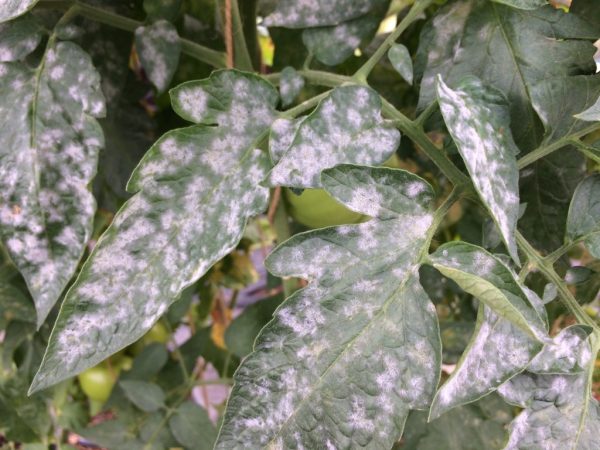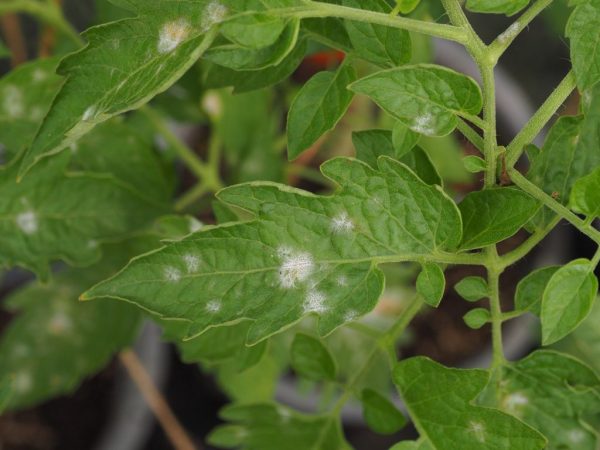Why do white spots appear on the leaves of tomato seedlings
Tomatoes are not considered a capricious crop, but like other vegetables, they can be subject to various diseases. Many gardeners believe that late blight disease is the most common disease that attacks tomato planting. However, tomato seedlings are sometimes exposed to other diseases and pest attacks. White spots on the leaves of tomato seedlings are not uncommon and occur even with proper care from experienced gardeners. The spots can vary in color, texture, size, and lesion. You should carefully study the nature of the spots in order to find out the specific reason for their appearance.

Causes of the appearance of white spots on the leaves of tomato seedlings
White spots on all tomato seedlings occur mainly on young plantings, since they have not yet developed immunity. Spotting and white streaks appear most often on large varieties of tomatoes. If you notice and prevent white spots on tomatoes in time, then you can heal the plantings and enjoy the harvest in the next season. The only good thing about the appearance of white spots is that it is not difficult to notice bloom or damage to seedlings. The main rule of growing tomatoes is to regularly water the plantings and not overdo it with fertilization.
Why do white spots appear on seedlings?
As soon as the gardener noticed the appearance of white spots, measures should be taken immediately to resolve this situation. First of all, it is worth understanding where the spots came from, and then deciding what methods should be used to get rid of the spotting.
White spots can appear for two reasons
- Sunburn or heat burn.
- Fungal infections.
It often happens that tomatoes grow beautifully, feel great, but as soon as the place of residence changes, they immediately lose their appearance. This is due to the fact that tomatoes are not used to the new place, especially when it comes to sunlight. In the case of sunburn, spots can be seen on the top leaves. At the initial stage of sunburn, the lower part of the plant is exposed to the disease, gradually affecting the seedlings to the very top.
Tomato seedlings burns
Usually such spots appear after the place of permanent residence has been changed. For example, the seedlings were taken outside and placed on the sunny side. Tomatoes should gradually get used to the sunlight. Every day, you need to take out the tomatoes closer to sunlight, starting from 10 minutes in the sun a day. Every day you can gradually increase the interval, but you cannot put tomatoes in direct rays. The tomatoes should be positioned so that they remain a little in the shade. The main thing is to constantly monitor the entire process in order to avoid burns, otherwise it is impossible to restore the burnt plant. The burn stops the normal development of the plant.
If, nevertheless, a seedling burn has occurred and only a small part of the leaves is affected, then you can help the plant a little. Spray tomato seedlings with epin solution. But this method is effective if the plant has burn spots and the leaves are not completely burned. Otherwise, it will no longer be possible to restore them. For fear of sunburn, many gardeners do not expose tomatoes to the sun, but you should not completely deprive seedlings of the daytime sun. Otherwise, the plantings will grow with poor immunity.
Watering is important and can sometimes negatively affect the plant. Do not water the seedlings in sunny weather. The remaining droplets on the leaves reflect the sunlight, and it looks like a magnifying glass effect. Thus, the leaves are damaged. The best time to water is always evening. The same goes for spraying. Sunburn occurs due to cold watering on hot soil and steam is released. Such watering and evaporation can harm your plantings. The steam burns the leaves and they can literally cook. Care should be taken in advance to ensure good ventilation in the room. After overheating, tomatoes no longer respond to treatment.
Fungal diseases of tomato
Previous lesions have similarities with each other and foci of white spots can be seen immediately. In the case of a fungal disease, the plant begins to get sick from the very root. This is due to the fact that the disease passes through the soil. The most affected plants, unfortunately, cannot be restored. You need to get rid of them so that the infection does not go to other plantings and all the bushes do not disappear. Greenhouses and hotbeds create even more favorable conditions for fungal diseases.
Common types of fungal diseases

There are several types of fungal diseases
- Powdery mildew. It affects the leaves with white moss and light spots. For prevention, you should often ventilate the room so that there is no strong greenhouse effect. Leaves begin to dry out prematurely. For the treatment of such a disease, such drugs as "Tsineba" and "Gaupsina" are suitable. A good solution would be to consult with a specialist in this field, since it is very difficult to fight this disease. During the rainy season, it is better to cultivate the soil with special agents to avoid unpleasant situations.
- Septoria. Also called "white spot". The disease usually affects the lower leaf area. With septoria, there are dirty and white spots. Hot weather becomes the cause of the appearance of septoria. Especially if hot weather is accompanied by high humidity. Often not only the leaves are the focus of the lesion, but also the stem. Severely infested leaves should be removed to avoid further spread of infection. After, the plant should be treated with phytosporin. The fungus, which is the cause of the lesion, hides in the soil for the winter. Therefore, in the fall, you need to remove all excess grass and cultivate the soil. If you do not take any action, then black spots appear on the white bloom.
- Mosaic rot. The marsupial fungus is the causative agent of the disease. A white-gray bloom appears on the lower part of the leaves, and yellow spots on the upper part. Unfortunately, the plant cannot be saved. It should be completely removed and the soil cultivated. It is important to observe the correct temperature regime, especially during the growing season.
- White rot. White rot develops when the air temperature is low and moisture is present. Lesions occur on plant stems and fruits. Later, the tissue softens and mucus is formed. The tomato is starting to wilt. A plant with such a lesion is very difficult to cure, and at the last stage it is not at all possible. To prevent the disease, it is required to monitor the level of humidity and temperature in the place where the tomatoes grow. It is not difficult to get rid of such a disease, the main thing is to notice it at the very initial stage.
- Late blight.It appears as a white bloom on the leaves. First, the tomato bush withers and then becomes soft. Many ways and means have been invented to fight. But it is worth remembering that late blight adapts perfectly to the new composition. For this reason, it is worth using several tools. If you need to remove the fruits, then it is definitely recommended to hold them in hot water for a couple of minutes. In this way, the fruit can be disinfected. This must be done, even if there is no damage to the fruit.
- Macrosporiasis. It also affects plants with rounded spots. First, the lower leaves are affected, and over time, the lesion passes to the upper leaves.
The appearance of white plaque and spots requires immediate treatment. Otherwise, the gardener will be forced to destroy the crop in order to avoid further damage, since the seedlings will no longer be able to fully develop. As the disease progresses, the leaves may curl and dry out.
How to prevent diseases from occurring?
To prevent spotting on tomato seedlings, the following rules must be followed:
- Compliance with comfortable conditions in the greenhouse.
- Before placing the seedlings in the soil, it must be well treated with a disinfectant solution.
- Plants that are heavily affected should be removed immediately.
- Enrich the soil with missing elements.
- You should worry in advance about the safety of the crop.
Only after establishing the exact reasons, one should begin to fight the disease.
Ways to fight
- Make sure that the sun's rays do not fall on the tomatoes.
- Periodically replenish the soil with useful additives and substances, but do not overdo it with their introduction.
- Destroy the affected leaves.
- If necessary, it is necessary to process the cuts with a garden pitch.
For the treatment of lesions, many use folk recipes. These include garlic tincture, dairy products, and the like. But such methods are effective at the earliest stage of the development of the disease, and it is quite difficult to keep track of this. Also, some summer residents pierce the stem with wire and use iodine. But this method is more about prevention than treatment. One small white blotch can lead to negative consequences of the development of the disease, if measures are not taken in time and the conditions for the growth of this culture are not foreseen in advance.
The harvest of tomatoes depends entirely on the conditions in which it grows. But in case of the onset of the disease, it can always be prevented at an early stage. If more unpretentious varieties are required, then you should pay attention to: "Amiko", "Joker", "Platus", "Shasta". By following simple rules, you can prevent tomato white spot damage, which damages the plant. If these actions do not work, then it is worth replacing the tomatoes with more resistant varieties to various factors of diseases. For your efforts, tomato seedlings will give you a bountiful and tasty harvest.


